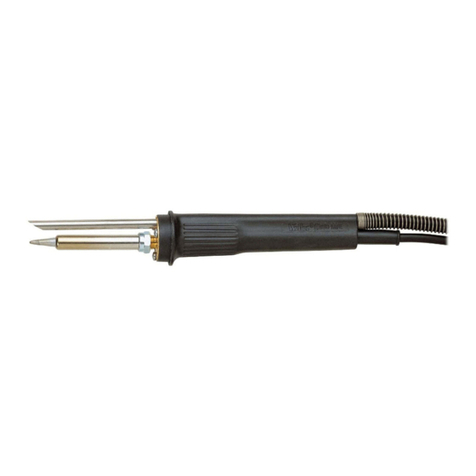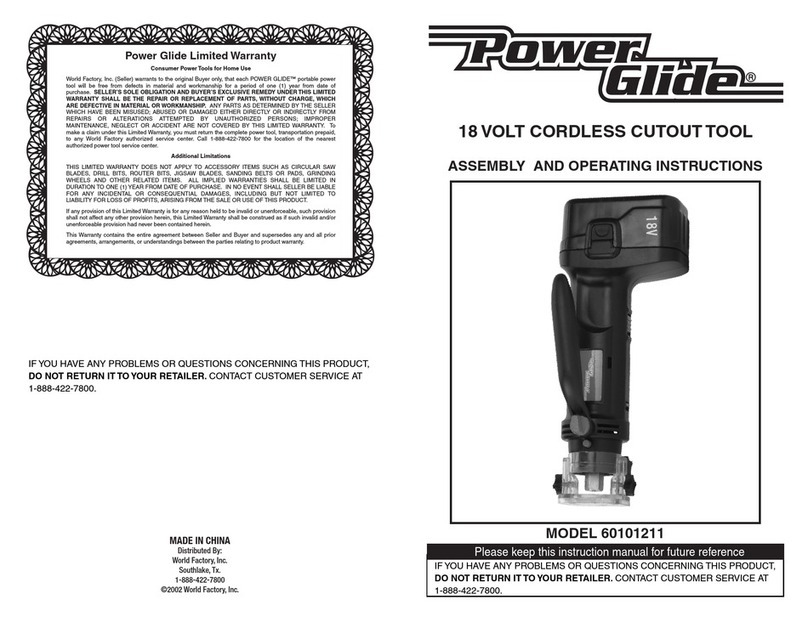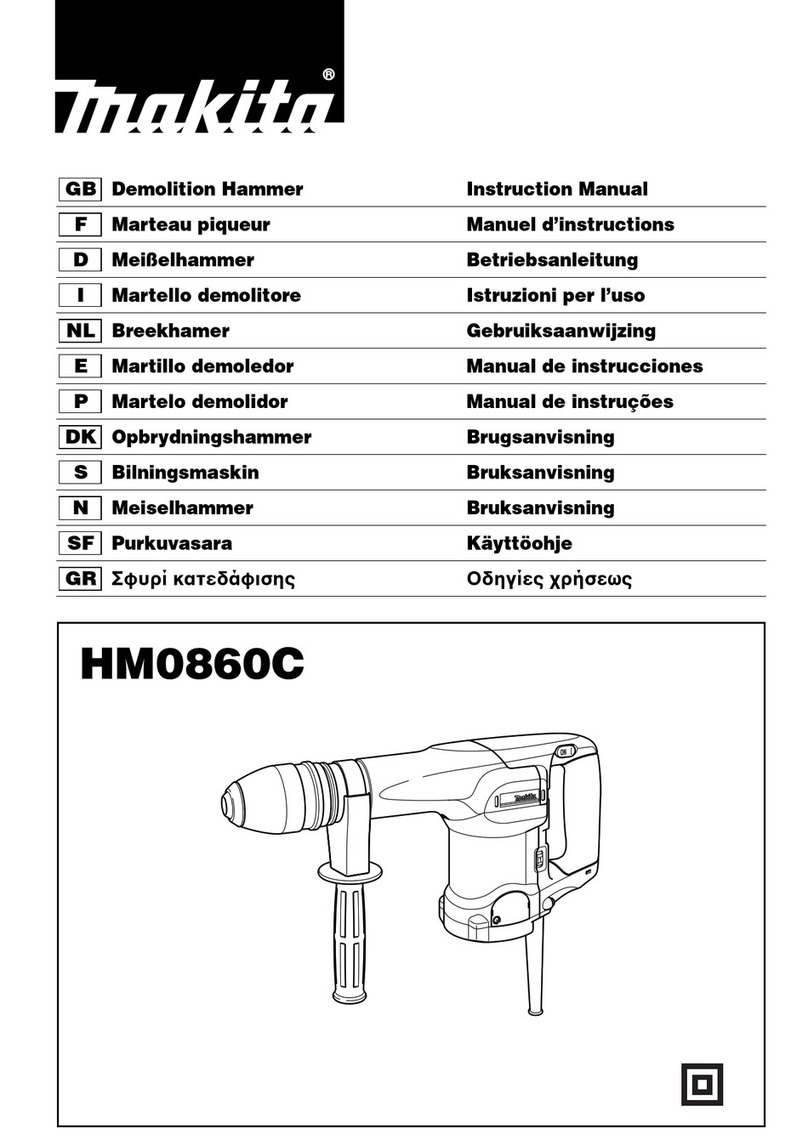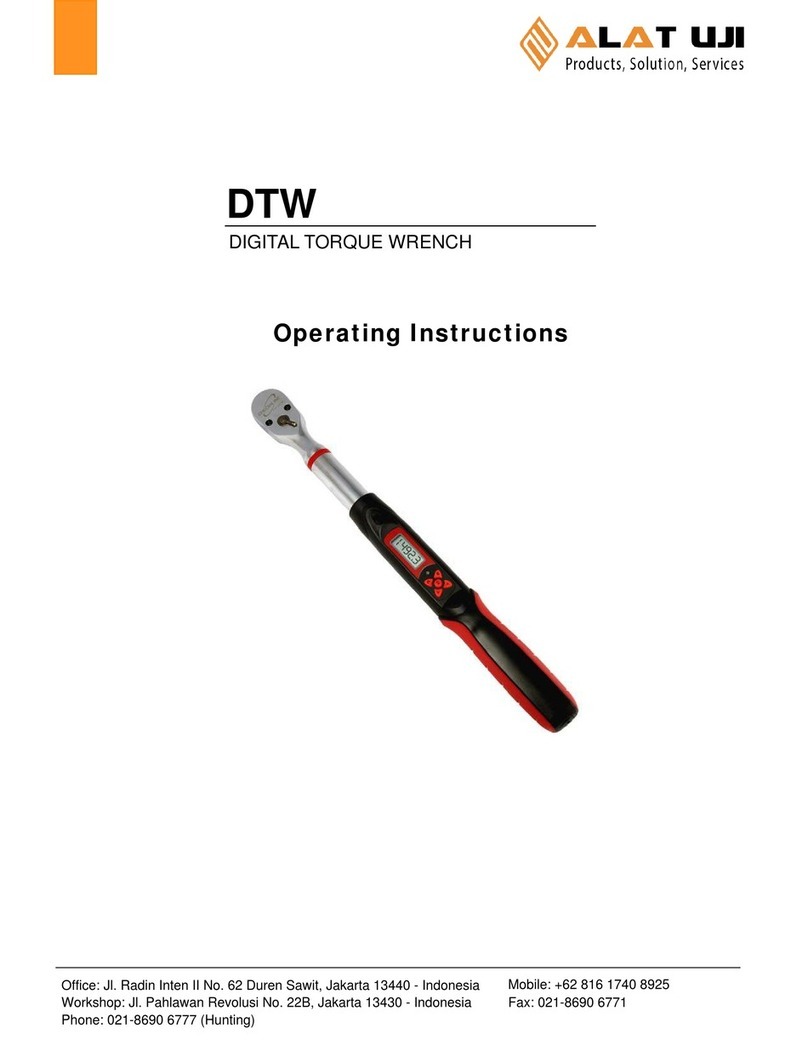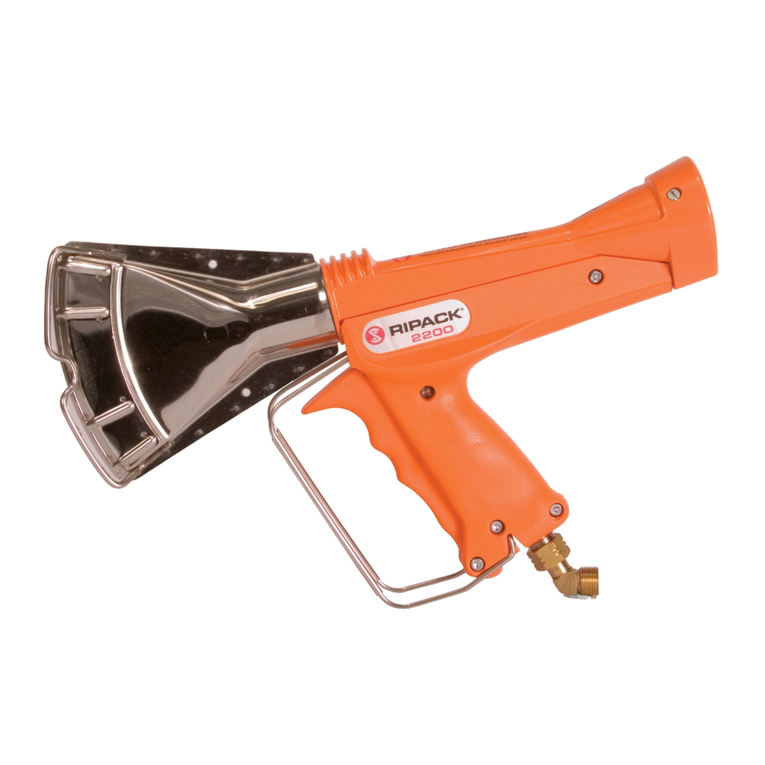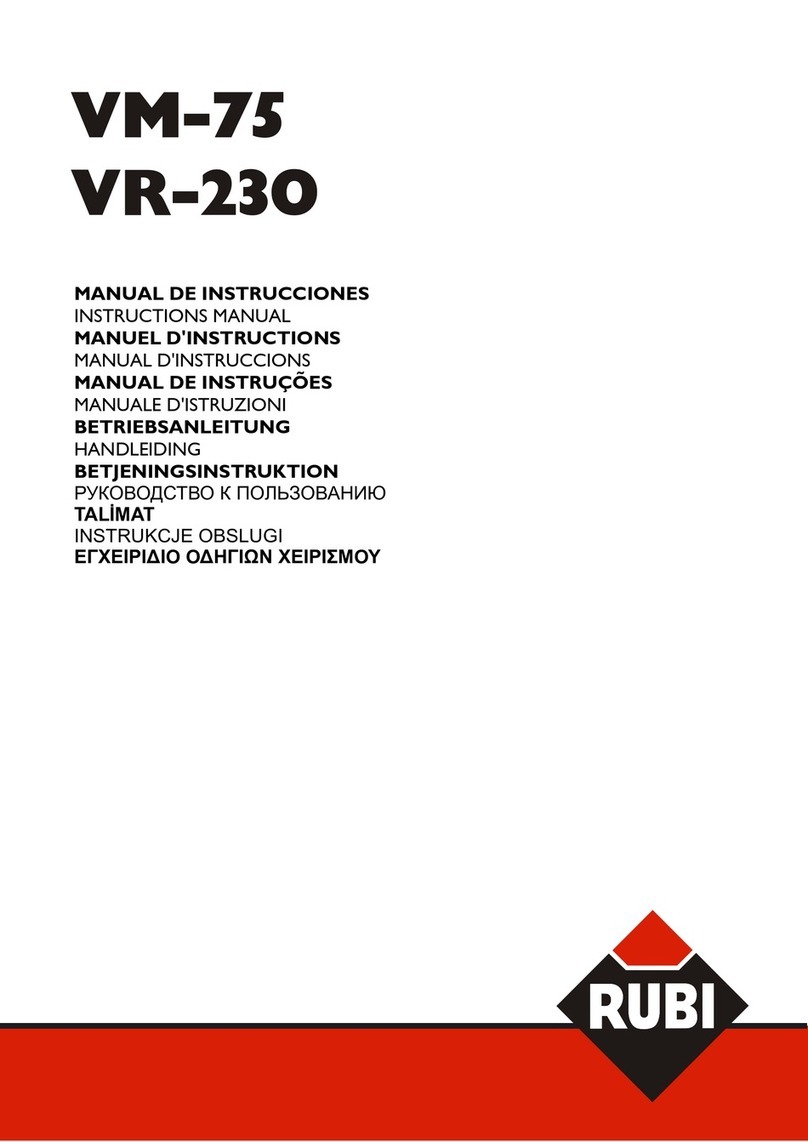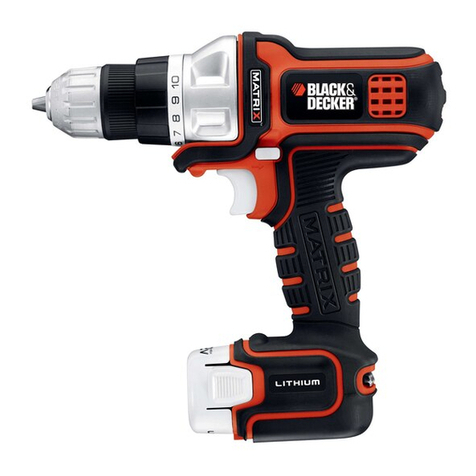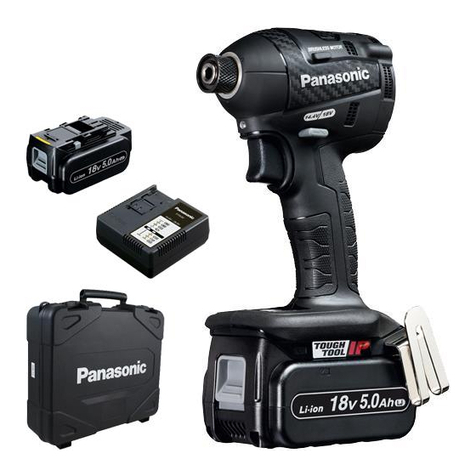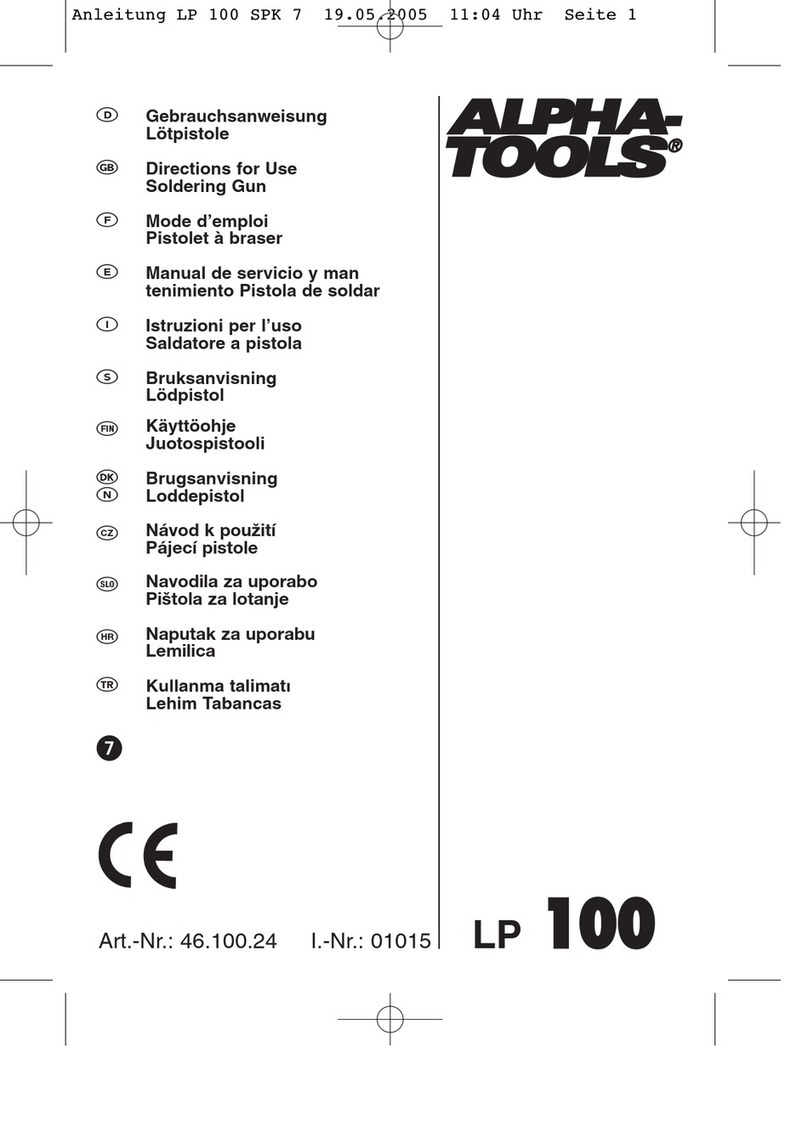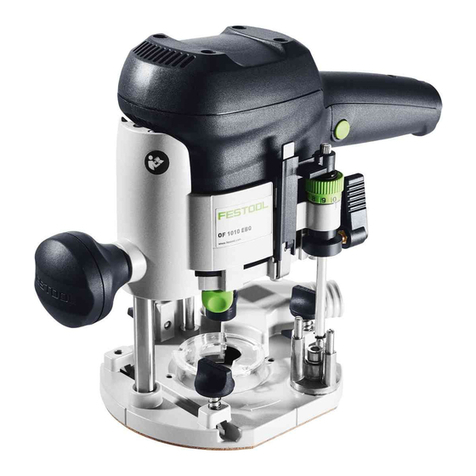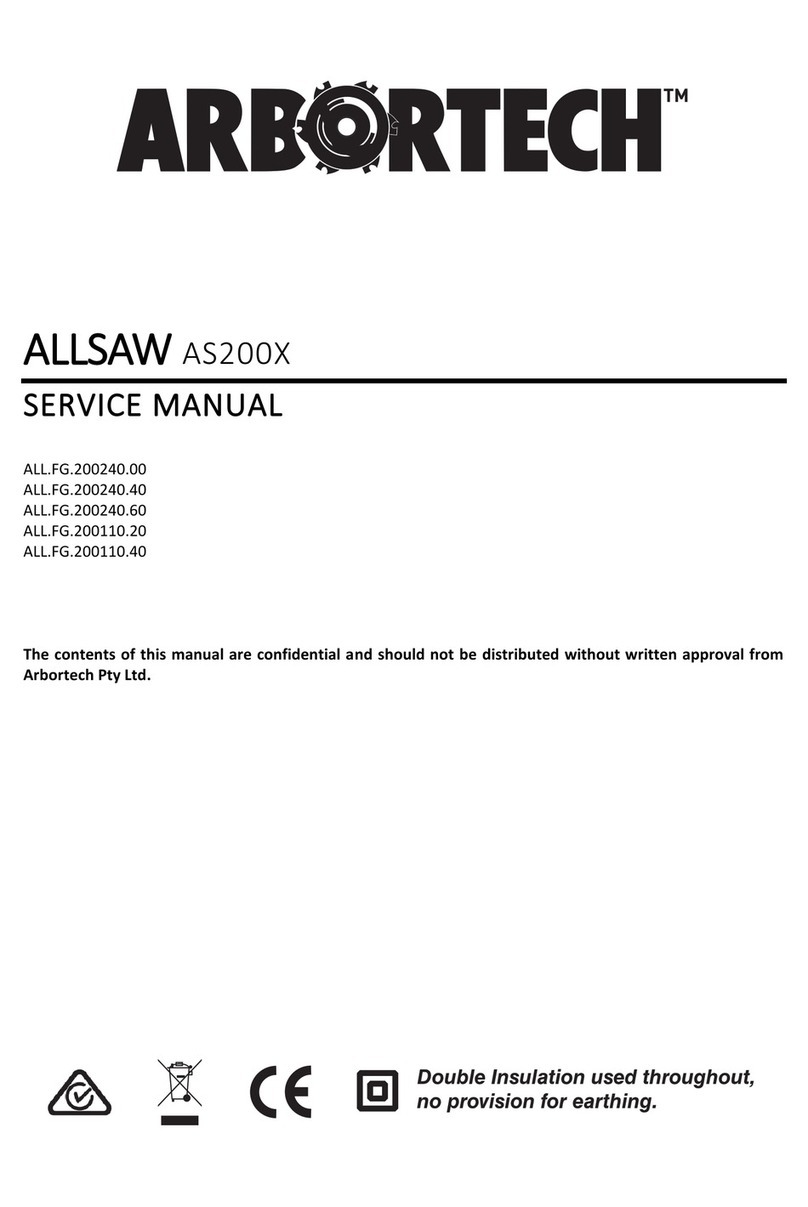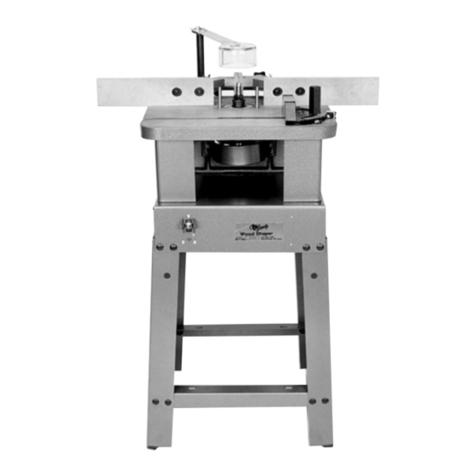Marco BLASTMASTER M Series User manual

Before using this equipment, read, understand and follow all instructions
in the Operator’s Manuals provided with this equipment. If the user and/
or assistants cannot read or understand the warnings and instructions,
the employer of the user and/or assistants must provide adequate and necessary training to
ensure proper operation and compliance with all safety procedures pertaining to this equipment. If
Operator’s Manuals have been lost, please visit www.marco.us, or contact Marco at 563.324.2519
for replacements. Failure to comply with the above warning could result in death or serious injury.
OPERATOR’S MANUAL
BLASTMASTER®MOBILE BLASTING
SYSTEMS

Blastmaster®Mobile Blasting Systems
1
Company Profile
Since 1944, Marco has developed a strong tradition of providing innovative and reliable products and services to the
surface preparation and protective coatings industries. We are the world’s premier provider of Abrasives, Blasting,
Coating, Dust Collectors, Engineered Systems, Rental, Safety, Service, Repair, & Modernization, and Vacuums.
Through innovative designs and a total commitment to quality, Marco manufactures products that increase production
rates, create a safer workplace, and reduce maintenance costs. Marco’s industry experience, manufacturing
capabilities, legendary customer service, product availability, logistics services, and technology leadership is your
assurance that we deliver high quality products and services, providing the best value to you, our customer.
The Marco Difference
•
Industry Experience – With Marco on your team, you have access to expertise which can only come from
decades of industry leadership. We have organized our engineering department, production specialists, customer
operations, and safety support into a “Center of Competence.” As a Marco customer, you have access to hundreds
of years of cumulative experience related to your operations.
•
Manufacturing Excellence – Marco is a U.S. based, ISO 9001:2008 certified manufacturer of equipment for the
Surface Preparation and Protective Coatings industries. Marco’s engineers benchmark the industry to ensure that
we design and manufacture superior products that set the “Gold Standard” for performance, safety, and quality.
• Legendary
Customer Service
–
Marco’s legendary customer service team is staffed by friendly, highly-trained
individuals who are focused on providing the highest level of product support, order accuracy, and customer
satisfaction.
•
Product Availability – We stock over 10,000 SKU’s and have more than 45 shipping locations to serve North
American and International markets for all major brands of blasting and coating equipment. As the largest provider of
surface preparation and protective coatings equipment in the world, our inventory levels and product availability are
unmatched.
•
Logistics Services – Marco’s in-house logistics team is dedicated to moving your shipment anywhere in the world.
We move more than 14,000 truckloads every year, allowing you to save on freight costs by leveraging our buying
power. Lower your process costs with a single invoice, which includes product and freight.
•
Technology Leadership – Our website provides: Operator’s Manuals, Part Numbers and Schematics Guides, SDS
information, and Features & Specifications Guides, providing access to information 24/7. Our Extranet application
allows you to receive quotes and place orders online. Our Intranet maintains a complete record of your purchase
history to assist with ongoing support of your existing equipment and future purchasing decisions.
Vision Statement
Marco is the world’s premier provider of Abrasives, Blasting, Coating, Dust Collectors, Engineered Systems, Rental,
Safety, Service, Repair, & Modernization, and Vacuums.
Mission Statement
Marco provides strong leadership and innovation to the surface preparation and protective coatings industries.
We dedicate our efforts to the continuous improvement of our products, services, processes, people, and most
importantly, the quality of our customer’s experience.
Quality Statement
Marco is committed to providing superior quality in the design, manufacturing, distribution, rental, service, and repair
of our products. Our ISO 9001:2008 certification extends throughout all operations in all locations. Continuous
improvement of our processes and supply chain Integration comprise the core of our business strategy for delivering
exceptional quality and value in all Marco products and services.
Management Philosophy
We are a company dedicated to the success of every customer and associate. We discuss, debate, challenge,
measure, and test our ideas. We will be boundless and limitless in our passion to improve. Through sound
leadership and dedicated associates, we will ensure a long term, profitable future for Marco, our associates,
customers, and suppliers.

Blastmaster®Mobile Blasting Systems 2
Company Prole . . . . . . . . . . . . . . . . . . . . . . . . . . . . 1
Denition of Terms . . . . . . . . . . . . . . . . . . . . . . . . . 2
Hazard Identications . . . . . . . . . . . . . . . . . . . . . . 3
Air & Abrasive Consumption Chart . . . . . . . . . . 6
Daily Pre-Operation Checklist . . . . . . . . . . . . . . . 8
Operating Instructions . . . . . . . . . . . . . . . . . . . . . . 9
Description . . . . . . . . . . . . . . . . . . . . . . . . . . . . . . . . 9
Initial Setup. . . . . . . . . . . . . . . . . . . . . . . . . . . . . . . . 9
Operating Instructions . . . . . . . . . . . . . . . . . . . . . . . 9
Installation of Bulk Bag Rack on 20.0 Cu. Ft.
Trailer-Mounted Abrasive Blasting Systems . . . . . . 15
Blast Hoses and Connections . . . . . . . . . . . . . . . . 17
Specications . . . . . . . . . . . . . . . . . . . . . . . . . . . . .18
Maintenance . . . . . . . . . . . . . . . . . . . . . . . . . . . . . . 21
Remove & Install Blast Pot . . . . . . . . . . . . . . . . . . . 21
Remove & Install Aftercooler . . . . . . . . . . . . . . . . . 22
Remove & Install 286 Airline Filter . . . . . . . . . . . . . 23
Troubleshooting . . . . . . . . . . . . . . . . . . . . . . . . . . . 24
TABLE OF CONTENTS
DEFINITION OF TERMS
This is an example of a warning. This indicates a
potentially hazardous situation which, if not avoided,
could result in death or serious injury.
This is an example of a notice. This indicates policy
or practice directly related to safety of personnel or
protection of property.
This is an example of danger. This indicates an
imminently hazardous situation which, if not avoided, will
result in death or serious injury.
This is an example of a caution. This indicates a
potentially hazardous situation which, if not avoided,
may result in minor or moderate injury. It can also be
used to alert against unsafe practices.
Literature References . . . . . . . . . . . . . . . . . . . . . 27
3.5 Cu. Ft. Abrasive Blasting Systems Literature
Reference Guide . . . . . . . . . . . . . . . . . . . . . . . . . . 27
6.5 Cu. Ft. Abrasive Blasting Systems Literature
Reference Guide . . . . . . . . . . . . . . . . . . . . . . . . . . 28
20.0 Cu. Ft. Abrasive Blasting Systems Literature
Reference Guide . . . . . . . . . . . . . . . . . . . . . . . . . . 29
Limited Warranty . . . . . . . . . . . . . . . . . . . . . . . . . . 30
Disclaimer of Warranty . . . . . . . . . . . . . . . . . . . . . . 30
Exclusive Remedy for Warranty Claims . . . . . . . . . 30
Limitation of Remedies . . . . . . . . . . . . . . . . . . . . . . 30

Blastmaster®Mobile Blasting Systems
3
Failure to comply with ANY WARNING listed below could result in death or serious injury.
OSHA sets exposure limits to protect workers from exposure to respirable crystalline silica, 29 CFR 1910.1053.
Airborne dust could increase the exposure levels beyond permissible limits. Breathing dust containing silica
could cause silicosis, a fatal lung disease. Breathing dust during abrasive blasting operations, post-blast cleaning
operations, and/or servicing equipment within the abrasive blasting area may expose an individual to conditions
that could cause asbestosis, lead poisoning and/or other serious or fatal diseases. Harmful dust containing toxic
material from abrasives or surfaces being abrasive blasted can remain suspended in the air for long periods of
time after abrasive blasting has ceased. A NIOSH-approved, well-maintained, respirator designed for the specific
operation being performed must be used by anyone abrasive blasting, handling or using the abrasive, and
anyone in the area of the dust.
Contact NIOSH and OSHA offices to determine the proper respirator for your specific application. The air supplied
to the respirator must be at least Grade D quality as described in Compressed Gas Association Commodity
Specification G-7.1 and as specified by OSHA Regulation 1910.134. Ensure air filter and respirator system hoses
are not connected to non-air sources or in-plant lines that may contain nitrogen, oxygen, acetylene or other
non-breathable gases. Before removing respirator, use an air monitoring instrument to determine if the
atmosphere is safe to breathe.
You must comply with all OSHA, local, City, State, Province, Country and jurisdiction regulations, ordinances and
standards, related to your particular work area and environment. Keep unprotected individuals out of the work
area.
Abrasive blasting operators must receive thorough training on the use of abrasive resistant attire which includes:
supplied-air respirator, abrasive blasting suit, safety shoes, gloves, ear protection and eye protection. Protect the
operator and bystanders by complying with NIOSH and OSHA Safety Standards.
Inspect all equipment for wear or damage before and after each use. Failure to use Original Equipment
Manufacturer repair parts and failure to immediately replace worn or damaged components could void warranties
and cause malfunctions.
OSHA requires abrasive blasting nozzles be equipped with an operating valve, which shall be designed to be
held open only by continuous hand pressure and shall close immediately upon release of hand pressure (i.e., a
“deadman” control). The valve shall not be modified in any manner that would allow it to remain open without the
application of continuous hand pressure by the operator. Failure to comply with the above warning could result in
release of high speed abrasive and compressed air resulting in death or serious injury. OSHA 29CFR 1910.244(b)
Point the abrasive blasting nozzle only at the surface being abrasive blasted. Never point the abrasive blasting
nozzle or abrasive stream at yourself or others.
Unless otherwise specified, maximum working pressure of abrasive blasting pots and related components must
not exceed 150 psi. Exceeding maximum working pressure of 150 psi could cause the abrasive blasting pot and
components to burst. Failure to comply with the above warning could result in death or serious injury.
Never weld, grind or drill on the abrasive blasting pot (or any pressure vessel). Doing so will void ASME
certification and manufacturer’s warranty. Welding, grinding or drilling on the abrasive blasting pot (or any pressure
vessel) could weaken the vessel causing it to burst. Failure to comply with the above warning could result in death
or serious injury. (ASME Pressure Vessel Code, Section VIII, Division 1)
This equipment is not intended for use in any area that might be considered a hazardous location, as described
in the National Electric Code NFPA 70, Article 500. Use of this equipment in a hazardous location could cause an
explosion or electrocution.
Never attempt to move an abrasive blasting pot containing abrasive. Never attempt to manually move abrasive
blasting pots greater than 6.5 cubic foot capacity. Always use at least two capable people to manually move an
abrasive blasting pot on flat, smooth surfaces. A mechanical lifting device must be used if an abrasive blasting pot
is moved in any other manner.
HAZARD IDENTIFICATIONS

Blastmaster®Mobile Blasting Systems 4
HAZARD IDENTIFICATIONS
Failure to comply with ANY WARNING listed below could result in death or serious injury.
This product is not for use in wet environments. Always use a Ground Fault Interrupter Circuit (GFIC) for
all electrical power source connections. Use of this product in wet environments could create a shock or
electrocution hazard.
Frozen moisture could cause restrictions and obstructions in pneumatic control lines. Any restriction or
obstruction in the pneumatic control lines could prevent the proper activation and deactivation of the remote
control system, resulting in the release of high speed abrasive and compressed air. In conditions where moisture
may freeze in the control lines an antifreeze injection system approved for this application can be installed.
Do not cut, obstruct, restrict or pinch pneumatic control lines. Doing so could prevent the proper activation and
deactivation of the remote control system, resulting in the release of high speed abrasive and compressed air.
Use of Marco remote control switches with other manufacturer’s remote control systems could cause unintended
activation of remote control systems resulting in the release of high speed abrasive and compressed air. Only
Marco remote control switches should be used with Marco remote control systems.
Always be certain to have secure footing when abrasive blasting. There is a recoil hazard when abrasive blasting
starts that may cause user to fall and misdirect the abrasive stream at operator or bystander.
Never use an abrasive blasting pot or attachments as a climbing device. The person could slip and fall. The
abrasive blasting pot could become unstable and tip over.
For equipment manufactured by entities other than Marco, you must consult the Original Equipment Manufacturer
operator’s manuals, information, training, instructions and warnings, for the proper and intended use of all
equipment.
Flammable fumes, such as solvent and paint fumes in the work area can present an ignition or explosion hazard
if allowed to collect in adequate concentrations. To reduce conditions that could result in a fire or an explosion,
provide adequate ventilation, eliminate all ignition or spark sources, keep the work area free of debris, store
solvents and solvent contaminated rags in approved containers, follow proper grounding procedures, do not
plug/unplug power cord or turn on/off power switches when flammable fumes are present, keep a working fire
extinguisher or provide another fire suppression system in the work area. Cease all operations and correct
condition if a spark or ignition source is identified during operation.
Always depressurize the entire system, disconnect all power sources and lockout/tagout all components before
any maintenance or troubleshooting is attempted. Failure to comply with the above warning could cause electrical
shock and inadvertent activation of equipment resulting in death or serious injury.
Moving parts can present an area where crushing, pinching, entanglement or amputation may occur. Do not
place body parts or foreign objects in any area where there are moving parts.
Surfaces of heated supply tanks, drums and/or lines as well as the adjoining plumbing may become hot during
normal use. Do not touch these heated surfaces without proper protection. Deactivate and allow sufficient time for
all surfaces to cool before attempting any maintenance.
High-pressure fluid from gun, hose leaks, or ruptured components can pierce skin and can cause a serious injury
that may result in amputation. Do not point gun or spray tip at anyone or at any part of the body. Keep clear
of any leaks or ruptures. Depressurize the entire system before attempting cleaning, inspecting, or servicing
equipment.
Exposure to toxic fluids or fumes may occur during the normal operation of this system. Before attempting to
fill, use, or service this system, read SDS’s to know the specific hazards of the fluids you are using. Always use
proper Personal Protective Equipment when attempting to fill, use, or service this system.
The use of this product for any purpose other than originally intended or altered from its original design is
prohibited.
Never hang objects from the abrasive blasting pot handle. Doing so may cause the abrasive blasting pot to
become unstable and tip over.

Blastmaster®Mobile Blasting Systems
5
HAZARD IDENTIFICATIONS
Failure to comply with ANY CAUTION listed below may result in minor or moderate injury.
Static electricity can be generated by abrasive moving through the abrasive blasting hose causing a shock
hazard. Prior to use, ground the abrasive blasting pot and abrasive blasting nozzle to dissipate static electricity.
High decibel noise levels are generated during the abrasive blasting process which may cause loss of hearing.
Ensure appropriate Personal Protective Equipment and hearing protection is in use.
Failure to comply with ANY NOTICE listed below could pose a hazard to personnel or property.
See Air & Abrasive Consumption Chart for estimated abrasive consumption rates and required air flow (cubic feet
per minute). Your system must meet these minimum requirements to ensure proper function and performance.
Always use abrasive that is dry and properly screened. This will reduce the potential for obstructions to enter the
remote control system, abrasive metering valve and abrasive blasting nozzle.
Moisture build-up occurs when air is compressed. Any moisture within the abrasive blasting system will cause
abrasive to clump, clogging metering valves, hoses and nozzles. Install an appropriately sized moisture separator
at the inlet of the abrasive blasting system. Leave the moisture separator petcock slightly open to allow for
constant release of water. If insufficient volume of air exists and petcock is unable to be left open (at all times)
petcock should be opened frequently to release water.
To reduce abrasive intrusion in the air supply hose, depressurize the abrasive blasting pot before shutting off air
supply from compressor.
Inspect abrasive blasting nozzle before placing into service. Damage to abrasive blasting nozzle liner or
jacket may occur during shipping. If you receive a damaged abrasive blasting nozzle, contact your distributor
immediately for replacement. Abrasive blasting nozzles placed into service may not be returned. Abrasive blasting
nozzle liners are made of fragile materials and can be damaged by rough handling and striking against hard
surfaces. Never use a damaged abrasive blasting nozzle.
Abrasive blasting at optimal pressure for the abrasive used is critical to productivity. Example: For an abrasive
with an optimal abrasive blasting pressure of 100 psi at the abrasive blasting nozzle, one pound per square inch
of pressure loss will reduce abrasive blasting efficiency by 1.5%. A 10 psi reduction in air pressure will cause a
15% loss of efficiency. Use a Needle Pressure Gauge to identify pressure drops in your system. Consult with your
abrasive supplier for the requirements of your abrasive.
Replace abrasive blasting nozzle if liner or jacket is cracked or damaged. Replace abrasive blasting nozzle if
original orifice size has worn 1/16” or more. Determine abrasive blasting nozzle wear by inserting a drill bit 1/16”
larger than original size of abrasive blasting nozzle orifice. If the drill bit passes through abrasive blasting nozzle,
replacement is needed.

Blastmaster®Mobile Blasting Systems 6
Failure to comply with ANY NOTICE listed below could pose a hazard to personnel or property.
See Air & Abrasive Consumption Chart for estimated abrasive consumption rates and required air flow
(cubic feet per minute). Your system must meet these minimum requirements to ensure proper function and
performance.
When it comes to air & abrasive mixtures, more is not necessarily better. Optimum abrasive blasting efficiency
takes place when a lean air & abrasive mixture is used. To correctly set the abrasive metering valve, begin
with the valve fully closed and slowly increase the amount of abrasive entering the airstream. As you increase
the abrasive flow, watch for a “blue flame” at the exit of the abrasive blasting nozzle. Faster cutting, reduced
abrasive consumption and lower clean up costs, are benefits of the “blue flame”.
Abrasive blasting at optimal pressure for the abrasive used is critical to productivity. Example: For an abrasive
with an optimal abrasive blasting pressure of 100 psi at the abrasive blasting nozzle, one pound per square inch
of pressure loss will reduce abrasive blasting efficiency by 1.5%. A 10 psi reduction in air pressure will cause a
15% loss of efficiency. Use a Needle Pressure Gauge to identify pressure drops in your system. Consult with
your abrasive supplier for the requirements of your abrasive.
*Abrasive consumption is based on abrasive with a bulk density of 100 lbs per Cubic Foot
Air & Abrasive Consumption Chart*
Nozzle
Orifice
Pressure at the Nozzle (PSI) Air (in cfm), Abrasive
& Compressor
Requirements
50 60 70 80 90 100 125 140
No. 2
(1/8ˮ)
11
67
2.5
13
77
3
15
88
3.5
17
101
4
18
112
4.5
20
123
5
25
152
5.5
28
170
6.2
Air (cfm)
Abrasive (lbs/hr)
Compressor Horsepower
No. 3
(3/16ˮ)
26
150
6
30
171
7
33
196
8
38
216
9
41
238
10
45
264
10
55
319
12
62
357
13
Air (cfm)
Abrasive (lbs/hr)
Compressor Horsepower
No. 4
(1/4ˮ)
47
268
11
54
312
12
61
354
14
68
408
16
74
448
17
81
494
18
98
608
22
110
681
25
Air (cfm)
Abrasive (lbs/hr)
Compressor Horsepower
No. 5
(5/16ˮ)
77
468
18
89
534
20
101
604
23
113
672
26
126
740
28
137
812
31
168
982
37
188
1100
41
Air (cfm)
Abrasive (lbs/hr)
Compressor Horsepower
No. 6
(3/8ˮ)
108
668
24
126
764
28
143
864
32
161
960
36
173
1052
39
196
1152
44
237
1393
52
265
1560
58
Air (cfm)
Abrasive (lbs/hr)
Compressor Horsepower
No. 7
(7/16ˮ)
147
896
33
170
1032
38
194
1176
44
217
1312
49
240
1448
54
254
1584
57
314
1931
69
352
2163
77
Air (cfm)
Abrasive (lbs/hr)
Compressor Horsepower
No. 8
(1/2ˮ)
195
1160
44
224
1336
50
252
1512
56
280
1680
63
309
1856
69
338
2024
75
409
2459
90
458
2754
101
Air (cfm)
Abrasive (lbs/hr)
Compressor Horsepower
No. 10
(5/8ˮ)
308
1875
68.5
356
2140
79.5
404
2422
90
452
2690
100.5
504
2973
112
548
3250
122
663
3932
146
742
4405
165
Air (cfm)
Abrasive (lbs/hr)
Compressor Horsepower
No. 12
(3/4ˮ)
432
2672
96
504
3056
112
572
3456
127
644
3840
143
692
4208
154
784
4608
174.5
948
5570
209
1062
6238
236
Air (cfm)
Abrasive (lbs/hr)
Compressor Horsepower
Inspect abrasive
blasting nozzle before
placing into service.
Damage to abrasive
blasting nozzle liner
or jacket may occur
during shipping. If you
receive a damaged
abrasive blasting nozzle,
contact your distributor
immediately for
replacement. Abrasive
blasting nozzles placed
into service may not
be returned. Abrasive
blasting nozzle liners
are made of fragile
materials and can be
damaged by rough
handling and striking
against hard surfaces.
Never use a damaged
abrasive blasting nozzle.
Replace abrasive
blasting nozzle if liner
or jacket is cracked
or damaged. Replace
abrasive blasting nozzle
if original orifice size
has worn 1/16” or more.
Determine abrasive
blasting nozzle wear by
inserting a drill bit 1/16”
larger than original size
of abrasive blasting
nozzle orifice. If the
drill bit passes through
abrasive blasting nozzle,
replacement is needed.
“Blue Flame”
AIR & ABRASIVE CONSUMPTION CHART

Blastmaster®Mobile Blasting Systems
7
“THE BIG PICTURE”
3
5
7
4
4
3
21
8
9
17
14
1615
13
19
18
10
20
23
21
424
27
26
25
22
28
5
3
6
11
12

Blastmaster®Mobile Blasting Systems 8
Daily Pre-operation Checklist
1. Abrasive
2. Air Compressor
3. Air Hose Couplings & Gaskets
4. Air Hose
5. Safety Cable
6. Ambient Air Pump*
7. Breathing Air Filter
8. CO Monitor
9. Breathing Line
10. Climate Control Device
11. Abrasive Blasting Suit
12. Gloves
13. Abrasive Blasting Nozzle
14. Lighting System*
15. Abrasive Blasting Nozzle Holder
16. Remote Control Switch
17. Supplied-Air Respirator
18. Control Line
19. Abrasive Blasting Hose
20. Abrasive Blasting Hose
Couplings & Gaskets
21. Abrasive Metering Valve
22. Remote Control System
23. Moisture Separator
24. Abrasive Blasting Pot Exhaust
Muffler
25. Abrasive Blasting Pot
26. Abrasive Blasting Pot Screen
27. Abrasive Blasting Pot Lid
28. Aftercooler*
* Optional or alternative device.
Ask your Marco Representative
for more details.
Abrasive – Select the correct Abrasive (1) for the application. Review the SDS
(Safety Data Sheet) to ensure the correct PPE (Personal Protective Equipment)
and Environmental Controls have been selected and are in place.
Air Compressor – Select an Air Compressor (2) of adequate size to support all
equipment requirements. Refer to “Air & Abrasive Consumption Chart” for
Abrasive Blasting Nozzle (13) air consumption requirements. Before connecting
Air Hose (4), sample the air being produced by the air compressor (2) to ensure
it is free of petroleum contaminants.
Air Hose, and Air Hose Couplings & Gaskets – Select Air Hoses (4) of
sufficient size to support all subsequent volumetric requirements and with a
sufficient PSI (pound per square inch) rating. Inspect all Air Hoses (4), and Air
Hose Couplings & Gaskets (3) for damage or wear. Repair or replace damaged
or worn components.
Abrasive Blasting Hose, Abrasive Blasting Hose Couplings & Gaskets, and
Abrasive Blasting Nozzle Holder – Select an Abrasive Blasting Hose (19) that
has an inner diameter 3 to 4 times larger than your Abrasive Blasting Nozzle
(13). Inspect Abrasive Blasting Hose (19), Abrasive Blasting Hose Couplings
& Gaskets (20), and Abrasive Blasting Nozzle Holder (15) for damage or wear.
Repair or replace damaged or worn components.
Safety Cables – Install a Safety Cable (5) at each Abrasive Blasting Hose (19),
and Air Hose (4) connection points.
Aftercooler and Moisture Separator – Ensure Aftercooler (28) is positioned
on stable ground. Keep petcock drain of Moisture Separator (23) slightly open
during use. Drain both devices after each use.
Supplied-Air Respirator, Breathing Line, Breathing Air Filter, Climate
Control Device, CO Monitor, Ambient Air Pump – You MUST consult the
Operator’s Manual supplied with your Respiratory Equipment (6, 7, 8, 9,
10, 17) for ALL applicable instructions and warnings. Inspect all Respiratory
Equipment components for damage or wear. Repair or replace damaged or worn
components.
Abrasive Blasting Suit and Gloves – Select an abrasive-resistant Abrasive
Blasting Suit (11) that is slightly oversized to allow ease of movement and allows
air to flow around your body. Select abrasive-resistant Gloves (12) with a tight fit
and a long cuff that overlaps the sleeve of the Abrasive Blasting Suit (11).
Abrasive Metering Valve and Abrasive Blasting Pot – Confirm Abrasive
Blasting Pot (25) is positioned on stable ground. Inspect Abrasive Blasting Pot
(25) and Abrasive Metering Valve (21) for damage or wear. Repair or replace
damaged or worn components.
Abrasive Blasting Pot Screen and Abrasive Blasting Pot Lid – Always use
an Abrasive Blasting Pot Screen (26) when filling Abrasive Blasting Pot (25)
with Abrasive (1) to prevent debris from entering the Abrasive Blasting Pot (25).
Remove Abrasive Blasting Pot Lid (27) before operating the Abrasive Blasting
Pot (25). Install Abrasive Blasting Pot Lid (27) after use to protect the Abrasive
Blasting Pot’s (25) interior.
Remote Control System, Remote Control Switch, Control Line, – Inspect
Remote Control System (22) and Control Line (18) for damage or wear. Repair
or replace damaged or worn components. Ensure Control Line (18) fittings
connected to the Remote Control System (22) are tight and free of leaks. Ensure
Remote Control Switch (16) is functioning properly. Consult Remote Control
Switch Operator's Manual for applicable instructions.
Abrasive Blasting Pot Exhaust Muffler – Inspect Abrasive Blasting Pot
Exhaust Muffler (24) at start and end of daily use. Replace element of Abrasive
Blasting Pot Exhaust Muffler (24) per Operator's Manual instructions.
Lighting System – Ensure the Lighting System (14) is connected to a proper
power supply before use.
DAILY PRE-OPERATION CHECKLIST

Blastmaster®Mobile Blasting Systems
9
Description
An blast pot is a pressure vessel used to contain a supply of abrasive material during the
blast process. Used as part of a mobile blasting system, the blast pot delivers a mixture of
abrasive and compressed air to the blast nozzle for surface preparation. By packaging a
high performance blast system on a trailer or skid, Marco has created high production blast
systems with unmatched portability and versatility. These systems combine an blast pot,
moisture management system, and a 6-Outlet airline filter together on a skid or trailer for
ease of portability. Typical applications include blast rooms, blast yards, oil refineries, and
pipelines. Common abrasives used include garnet, mineral abrasives, and slags.
Operational Requirements
• Proper air supply to provide a minimum of 50 psi to a maximum of 150 psi working
pressure.
The following may cause safety hazards or reduced performance:
• Improper installation and/or maintenance of components.
• Failure to place Blastmaster®Mobile Blasting System on a secure, flat surface.
• Improper air supply pressure. See operator’s manuals for proper psi ratings.
• Incorrect lifting/transporting of Blastmaster®Mobile Blasting System or incorrect or worn
lifting devices.
Initial Setup
• Place Blastmaster®Mobile Blasting Systems on a secure level surface that can withstand
the weight with a full Blast Pot. Be aware of possible erosion of surface and load shifting.
• Connect air supply hose from compressor to Inlet (5) of Aftercooler (14). To provide best
performance, an air supply hose with an inner diameter five to six times the size of blast
nozzle orifice is recommended.
• Connect blast hose to Coupling (10) installed on Abrasive Metering Valve (9).
Operating Instructions
Operating Instructions are limited to the instructions found in the Original Equipment
Manufacturer’s Operator’s Manuals. Please refer to all literature included with your
Blastmaster®Mobile Blasting Systems at time of delivery. If this literature is unavailable,
please contact Marco for a replacement set before use.
Before use - BLAST POT:
Note: Do not operate this equipment without a pressure relief device in place. It is the end
users responsibility to provide.
• Inspect entire system for air leaks or damage. Repair or replace damaged components.
• Ensure sufficient compressed air supply volume and/or pressure.
• Inspect Pop-Up Valve Seat (2) and Pop-Up Valve (3) for damage. Replace damaged
components before use.
• Inspect Muffler Assembly (4) for wear and abrasive. Repair or replace as needed.
• Inspect remote control system components as instructed in the device’s Operator’s
Manual.
• Inspect Pusher Line (8) for damage. Replace damaged components before use.
• Inspect Blast Pot (1) for damage. Do not use Blast Pot if damaged.
OPERATING INSTRUCTIONS
Read, understand, and
follow the Original
Equipment Manufacturer
operator’s manuals,
information, training,
instructions, and
warnings, for the proper
and intended use of all
equipment. Failure to
comply with the above
warning could result in
death or serious injury.
W-594
Inspect all equipment for
wear or damage before
and after each use.
Failure to use Original
Equipment Manufacturer
repair parts and failure
to immediately replace
worn or damaged
components could void
warranties and cause
malfunctions. Failure to
comply with the above
warning could result in
death or serious injury.
W-505
Do not operate this
equipment without
the proper pressure
relief device in place.
Exceeding maximum
working pressure
could cause vessel or
components to burst.
Failure to comply with
the above warning
will result in death or
serious injury. ASME
STANDARD PTC25-
2014. OSHA Standard
1910.169 (B)(3)(i).
D-507
The use of this product
for any purpose other
than originally intended
or altered from its
original design is
prohibited. Failure to
comply with the above
warning could result in
death or serious injury.
W-520

Blastmaster®Mobile Blasting Systems 10
OPERATING INSTRUCTIONS
Before use - AFTERCOOLER:
• Using a screwdriver or similar device, gently rotate Fan Blades to confirm free movement.
If the Fan Blades do not move freely, remove obstruction or replace Fan Blade and Motor
Assembly before use. See Aftercooler Operators Manual.
• Open Drain Valves (15,16) to release any liquid. Close Drain Valves once liquid stops
flowing.
• Fill Air Motor Lubricator (17) with SAE 10 oil or air tool anti-freeze lubricant.
• Close Ball Valves (7,11).
• Turn on compressor air supply.
• Slowly open Inlet Ball Valve (7), looking and listening for leaks.
• If leaks are found, turn off air supply, open Drain Valve (15), allow air pressure to
completely release. Repair leaks as needed.
• Slightly open Drain Valve (15) to release collected moisture.
• Slowly open Air Supply Ball Valve (18) to Air Motor (19).
• Adjust Air Motor Pressure Regulator (20) to 60 psi for proper Cooling Fan speed. Do not
exceed 60 psi.
• Watch the lubricant flow through the combination Control Knob/ Sight Dome (21) on
top of the Air Motor Lubricator, adjust the flow to one drop per minute. NOTE: Failure to
maintain lubrication will cause the motor to fail.
Always depressurize
the entire system,
disconnect all power
sources and lockout/
tagout all components
before any maintenance
or troubleshooting is
attempted. Failure to
comply with the above
warning could cause
electrical shock and
inadvertent activation of
equipment resulting in
death or serious injury.
W-562
1
23
5
10
7
9
11
6
8
4
13
12
14
15
16
17 18
19
20 21
This product is
not for use in wet
environments. Always
use a Ground Fault
Interrupter Circuit (GFIC)
for all electrical power
source connections.
Use of this product
in wet environments
could create a shock or
electrocution hazard.
Failure to comply with
the above warning
could result in death or
serious injury.
W-519
You must comply
with all OSHA, local,
City, State, Province,
Country and jurisdiction
regulations, ordinances
and standards, related
to your particular work
area and environment.
Keep unprotected
individuals out of the
work area. Failure to
comply with the above
warning could result in
death or serious injury.
W-503

Blastmaster®Mobile Blasting Systems
11
OPERATING INSTRUCTIONS
The 286 Series Airline
Filters do not remove
carbon monoxide or
any other toxic gases.
Review, understand
and follow all federal
and state safety
regulations regarding
the use of supplied-air
respirators. Failure to
avoid the above danger
will result in death or
serious injury. OSHA
REGULATION 1910.134
W-591
Before use - 286 AIRLINE FILTER:
• Inspect components for damage. Replace damaged components before use.
• Ensure Nuts (4) are tight. Tighten Nuts using an alternating pattern.
• If equipped with a pressure regulator, ensure Pressure Regulator (2) is turned to closed
position.
• Ensure Airline Fittings (1) installed on Airline Filter are compatible with the device to be
attached. See Operator's Manual for connected device for recommended airline
fittings.
• Slowly turn on air supply and check for air leaks. Repair leaks as needed.
• Check Pressure Relief Valve (3) (if equipped) for proper operation. Replace as needed.
During use - 286 AIRLINE FILTER:
• Set appropriate air pressure for connected devices by rotating the knob of Pressure
Regulator (2). (See Operator’s Manual of connected device(s) for recommended air
supply pressure level.)
• Periodically open Petcock (5) to allow condensate to drain. For continuous draining of
condensate, operate with Petcock in a slightly open position.
• Monitor air supply pressure to connected device(s) using Pressure Gauge (5). Adjust air
flow pressure of compressed air as needed.
• If an operator sees, tastes, smells, or feels contaminants inside a supplied-air respirator
connected to the Barricade®286 Airline Filter, stop use of the Barricade®286 Airline
Filter. Remove and dispose of Filter Cartridge, clean interior of Filter Housing using a
mild detergent soap, and install a new Filter Cartridge. Ensure compressed air supply
connected to Barricade®286 Airline Filter is at least Grade D quality as described in
Compressed Gas Association Commodity Specification G-7.1 and as specified by OSHA
Regulation 1910.134.
Do not connect 286
Airline Filter and
respirator system to an
air source containing
carbon monoxide or
other toxic gases.
Ensure air source is
Grade D or higher
quality. Failure to
comply with the above
warning could result in
death or serious injury.
W-617

Blastmaster®Mobile Blasting Systems 12
OPERATING INSTRUCTIONS
1
2
3
4
5

Blastmaster®Mobile Blasting Systems
13
During use - MOBILE BLASTING SYSTEMS:
• Ensure Blast Pot is not pressurized. Fill Blast Pot (1) through hole in top of Blast Pot. Do
not overfill.
• Close Ball Valves (2,8).
• Open Ball Valves (5,6) on Aftercooler.
• Open Ball Valve (2) to pressurize Blast Pot (1).
• Open Ball Valve (8).
• To start/stop abrasive blasting, refer to remote control system Operator’s Manual.
• Monitor remote control system components per Operator’s Manual.
• Check volume of lubricant in Air Motor Lubricator (9) every 60 minutes. Add lubricant as
needed.
• Observe Drain Valve (15) for release of liquids. If no liquid is being released, adjust as
needed.
After use:
• Empty abrasive from Blast Pot when blasting is concluded for the day. To remove
abrasive, place Metering Valve (3) in FULL OPEN position. Close Ball Valve (8). Remove
Blast Nozzle from nozzle holder on blast hose.
Note: Place blast hose in a container suitable for catching abrasive. Be prepared for strong
recoil, the blast hose will provide strong recoil as abrasive exits blast hose.
• Activate remote control system per Operator’s Manual. When Blast Pot is empty, only
air will exit blast hose. Deactivate remote control system. Place Metering Valve (3) in
CLOSED position.
• Turn off air supply.
• Close Ball Valve (2) on Blast Pot.
• Inspect Blast Pot components for damage. Replace damaged components before use.
• Cover Blast Pot when not in use to reduce debris and water intrusion.
• Close Air Supply Inlet Ball Valve (10) to Air Motor (11).
• Slowly open Drain Valve (13) to release collected liquid and stored compressed air. Once
all pressure is released, close Inlet Ball Valve (4) disconnect compressed air supply from
Air Inlet (7).
• Close Drain Valves (12,13).
• Slowly move lever of Petcock (14) to the fully open position to drain residual condensate.
• Close Petcock (14) after air and condensate have emptied from Airline Filter.
• Clean Blastmaster®Mobile Blasting System.
Read, understand, and
follow the Original
Equipment Manufacturer
operator’s manuals,
information, training,
instructions, and
warnings, for the proper
and intended use of all
equipment. Failure to
comply with the above
warning could result in
death or serious injury.
W-594
Inspect all equipment for
wear or damage before
and after each use.
Failure to use Original
Equipment Manufacturer
repair parts and failure
to immediately replace
worn or damaged
components could void
warranties and cause
malfunctions. Failure to
comply with the above
warning could result in
death or serious injury.
W-505
Do not operate this
equipment without
the proper pressure
relief device in place.
Exceeding maximum
working pressure
could cause vessel or
components to burst.
Failure to comply with
the above warning
will result in death or
serious injury. ASME
STANDARD PTC25-
2014. OSHA Standard
1910.169 (B)(3)(i).
D-507
The use of this product
for any purpose other
than originally intended
or altered from its
original design is
prohibited. Failure to
comply with the above
warning could result in
death or serious injury.
W-520
OPERATING INSTRUCTIONS

Blastmaster®Mobile Blasting Systems 14
OPERATING INSTRUCTIONS
High decibel noise
levels are generated
during the abrasive
blasting process
which may cause loss
of hearing. Ensure
appropriate Personal
Protective Equipment
and hearing protection
is in use. Failure to
comply with the above
caution may result
in minor or moderate
injury.
C-501
Never weld, grind or drill
on the abrasive blasting
pot (or any pressure
vessel). Doing so will
void ASME certification
and manufacturer’s
warranty. Welding,
grinding or drilling on
the abrasive blasting
pot (or any pressure
vessel) could weaken
the vessel causing it to
burst. Failure to comply
with the above warning
could result in death or
serious injury. (ASME
Pressure Vessel Code,
Section VIII, Division 1)
W-516
Always depressurize
the entire system,
disconnect all power
sources and lockout/
tagout all components
before any maintenance
or troubleshooting is
attempted. Failure to
comply with the above
warning could cause
electrical shock and
inadvertent activation of
equipment resulting in
death or serious injury.
W-562
10
11
12
1
2
3
4
5
6
78
9
13
14

Blastmaster®Mobile Blasting Systems
15
Always depressurize
the entire system,
disconnect all power
sources and lockout/
tagout all components
before any maintenance
or troubleshooting is
attempted. Failure to
comply with the above
warning could cause
electrical shock and
inadvertent activation of
equipment resulting in
death or serious injury.
W-562
Transporting, lifting,
or moving this device
must be in accordance
with applicable OSHA
standards and ASME
B30 standards, as
well as any applicable
local, state, or federal
requirements. Failure to
comply with the above
warning could result in
death or serious injury.
W-578 After use:
1) Remove Locking Pins (6) from Bulk Bag Rack Collar Pin Holes (5).
2) Attach lifting device to Bulk Bag Rack Lifting Eyes (1), or use Fork Pockets, if
equipped.
3) Raise Bulk Bag Rack out of Bulk Bag Rack Collars (4) and lower to the ground.
4) Inspect Bulk Bag Rack for damage or wear.
Installation:
1) Depressurize blast pot per blast pot Operator’s Manual.
2) Ensure Locking Pins are not inserted in Bulk Bag Rack Collar Pin Holes (5).
3) Attach lifting device to Bulk Bag Rack Lifting Eyes (1), or use Fork Pockets, if
equipped.
4) Raise and position Rack Legs (3) in Bulk Bag Rack Collars (4).
5) Insert Locking Pin (6) through Pin Holes (5) in Bulk Bag Rack Collar (4) and Rack
Legs (3). Repeat on remaining three Bulk Bag Rack Collars.
6) If equipped, open gate assembly by pulling down on chain assembly rope (2), and
swing gate open.
7) Utilizing appropriate lifting device, place Abrasive Bulk Bag (8) in Blastmaster® Bulk
Bag Rack (7).
8) If equipped, swing gate assembly back into place and verify that it has latched into
position.
Keep clear of Bulk Bag
Rack Collars when
lowering or raising Bulk
Bag Rack into operating
position. Do not attempt
to guide the Bulk Bag
Rack into position with
the use of hands or
feet. Failure to comply
with the above warning
could result in death or
serious injury.
W-580
Inspect all equipment for
wear or damage before
and after each use.
Failure to use Original
Equipment Manufacturer
repair parts and failure
to immediately replace
worn or damaged
components could void
warranties and cause
malfunctions. Failure to
comply with the above
warning could result in
death or serious injury.
W-505
Installation of Bulk Bag Rack on 20.0 Cu. Ft. Abrasive Blasting Systems
OPERATING INSTRUCTIONS

Blastmaster®Mobile Blasting Systems 16
Do not transport
abrasive blasting pot
with bulk bag rack
installed. Transporting
abrasive blasting pot
with bulk bag rack
installed could cause
the abrasive blasting pot
to become unstable or
allow the bulk bag rack
to become disengaged
from the abrasive
blasting pot. Failure to
comply with the above
warning could result in
death or serious injury.
W-582
Always remove any
locking device securing
the bulk bag rack before
attempting removal. Do
not use the installed
bulk bag rack as a lifting
device for the blast pot.
Lifting a blast pot using
the bulk bag rack can
cause the blast pot to
become unstable and
damage components.
Failure to comply with
the above warning
could result in death or
serious injury.
W-581
Installation of Bulk Bag Rack on 20.0 Cu. Ft. Abrasive Blasting Systems
(Cont.)
1
2
3
6
5
7
4
8
OPERATING INSTRUCTIONS

Blastmaster®Mobile Blasting Systems
17
OPERATING INSTRUCTIONS
Hoses and Connections
1
2
Blast hoses and air hoses are a high wear component of the abrasive blast system. Sharp
bends in the blast hose create high wear points resulting in soft spots that can fail while
blasting. Check the full length of the blast hose assembly for soft spots caused by wear. To
protect against serious injury to personnel replace blast hoses with soft spots.
Most air hose, blast hose, and threaded couplings have pin holes that align when
connected. To protect against unintentional hose disconnections, four Safety Pins (1)
must be installed through these holes. As a secondary safety measure each hose
connection should also include a Hose Whip Check (2) that will hold the hose if there is an
unintentional disconnection. Connect one loop to each side of connection and stretch out as
shown below.
Most air hose, blast hose, and threaded couplings have gaskets that seal the connection.
To reduce loss of air pressure and/or premature abrasive wear replace these gaskets when
leaks are found. Replace gaskets when visible wear or leaks are found.
Leaks around couplings and nozzle holders could indicate worn or loose fitting parts. They
could disconnect while under pressure. Inspect all couplings and nozzles daily for worn or
loose fitting parts. Check nozzle threads for wear.
Always depressurize
the entire system,
disconnect all power
sources and lockout/
tagout all components
before any maintenance
or troubleshooting is
attempted. Failure to
comply with the above
warning could cause
electrical shock and
inadvertent activation of
equipment resulting in
death or serious injury.
W-562
Worn blast hose
assemblies can fail
while blasting. Check
the full length of blast
hose assembly for soft
spots caused by wear.
Replace blast hoses that
show signs of excessive
wear. Failure to comply
with the above caution
may result in minor or
moderate injury.
C-515
Leaks around couplings
and nozzle holders
indicate worn or loose
fitting parts. They could
disconnect while under
pressure. Inspect all
couplings and nozzles
daily for worn or loose
fitting parts. Inspect
nozzle threads for
wear. Failure to comply
with the above caution
may result in minor or
moderate injury.
C-516

Blastmaster®Mobile Blasting Systems 18
SPECIFICATIONS
» Height: 4 Feet, 10 Inches
» Length: 6 Feet
» Width: 4 Feet
» Total System Dry Weight: 1,100 lbs.
3.5 Cu. Ft. Skid-Mounted Abrasive
Blasting Systems
3.5 Cu. Ft. Trailer-Mounted Abrasive
Blasting Systems
» Overall Trailer Length: 11 Feet, 7 Inches
» Overall Trailer Width: 6 Feet, 6 Inches
» Deck Length: 8 Feet
» Deck Width: 5 Feet
» Height: 6 Feet, 5 Inches
» Overall System Dry Weight: 2,100 lbs.
3.5 Cu. Ft. M-Series 16’ Trailer-Mounted
Abrasive Blasting Systems
» Overall Trailer Length: 22 Feet, 5 Inches
» Overall Trailer Width: 8 Feet, 5 Inches
» Deck Length: 18 Feet
» Deck Width: 6 Feet, 5 Inches
» Height: 6 Feet
» Overall System Dry Weight: 3,500 lbs.

Blastmaster®Mobile Blasting Systems
19
SPECIFICATIONS
» Height: 4 Feet, 10 Inches
» Length: 6 Feet
» Width: 4 Feet
» Overall System Dry Weight: 1,200 lbs.
6.5 Cu. Ft. Skid-Mounted Abrasive
Blasting Systems
6.5 Cu. Ft. Trailer-Mounted Abrasive
Blasting Systems
» Overall Trailer Length: 11 Feet, 7 Inches
» Overall Trailer Width: 6 Feet, 6 Inches
» Deck Length: 8 Feet
» Deck Width: 5 Feet
» Height: 6 Feet, 5 Inches
» Overall System Dry Weight: 2,200 lbs.
This manual suits for next models
1
Table of contents

